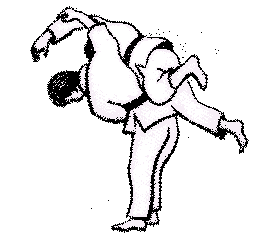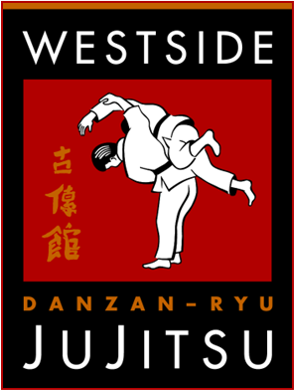



Three phases of training in the Danzan Ryu system constitute the body of each class. These include the calisthenics (warm-ups), the rolls and falls (sutemi), and the arts of the system.
Calisthenics are done before every class. These exercises are designed to limber and warm you by stretching the tendons and muscles so that injuries are less likely to occur during a workout.
The second phase of your training is that of sutemi (rolls and falls). Correct rolling and falling techniques are crucial and required for your safety and that of your partner before you can learn the arts of the system. The sutemi involve slapping the tatami (workout mat) in an effort to evenly distribute the force of your body landing after being thrown. With the force evenly distributed throughout your body, you can fall many times in a workout. The sutemi also help develop timing and coordination. As a result of this phase of your training, you will always be aware of your relative position in relation to the mat and are always in control of your movements while tumbling or being thrown. This is to help prevent injury to you or your partner.
The third phase of your training includes the arts of the system. Professor Okazaki arranged and divided the techniques into lists according to their type and extent of danger. Lists consist of 20 to 35 techniques and each list is built upon the preceding list. These courses of arts constitute the most exhaustive and difficult part of your training. To progress you must prove yourself worthy each step of the way.
The first course taught is yawara, which is a list of 20 hand and wrist techniques including both escapes and submission arts. This course usually coincides with your training in rolling and falling. The second course is nage no kata, consisting of 20 basic throwing techniques. This course is primarily built upon the preceding course and is cumulative, as are the rest of the courses in the system. Third is shime no kata, a course of 25 techniques involving choking and grappling with an opponent after they have been thrown. Beyond that are more advanced courses including oku no kata, kiai no maki, shinnin no maki, and others that are taught to black belts. Kappo and seifukujitsu (first aid and restorative massage) techniques are introduced at the kyu (non-black belt) level and are a major focus of the dan (black belt) study.

Before attempting any art or technique, remember safety always comes first.
In Judo and Jujitsu, it has been found that when one wants to show submission, it is easier, faster, and safer to repeatedly (2 to 3 times) slap the mat or tap the person applying the technique than to say something. Remember, these techniques DO work when applied; tap-slap before you are injured.
Students will immediately report all injuries to the sensei.
Students should never attempt any technique or sutemi not previously explained and practiced. Techniques applied without previous experience can lead to serious injury.
Always be safety conscious and GO EASY. Students should never substitute strength for skill and technique. Forcing an art or resisting an art is a main cause of injury.
NEVER, NEVER try to break a fall with hand outstretched or elbow locked. This will lead to a serious and possibly disabling injury.
All students are required to put together a notebook to keep all materials and notes in an orderly manner. The notebook is used to record (in the students own words) the exact method our school teaches for each art, variation, or concept, as taught by the instructors. Additional arts and variations from outside sources may also be included. This notebook will be very useful in martial arts study. For starters, a new student should have sections in their note book for: the basic lists (Yawara, Nage, Shime), History, Philosophy / Inspiration, and Character Development. It is recommended for students to bring their notebooks to each class and to make appropriate notations for future reference. If you have any questions regarding your notebook, or obtaining information / lists, please ask a higher ranking student or an instructor.
Class begins with the ceremonial kneeling bow, with the sensei and black belts sitting facing the class. After the opening bow, the class spreads out for warm-up exercises. Exercises should be done to each individuals capacity (an honest effort should be made). Following exercises, students line up on each side of the mat for rolling and falling exercises. Beginning students should only participate in exercises in which they have been instructed. Following rolling and falling, the head instructor will make assignments. At the end of class, there are often demonstrations by students from all levels of the class. Participation in these demonstrations gives the student an opportunity to work under pressure and is an important learning tool. Class is then closed with another ceremonial kneeling bow.
| Sensei | Teacher; applicable to any black belt on the mat. |
| Jujitsuka | Jujitsu player |
| Dojo | Practice hall |
| Gi | Jujitsuka uniform |
| Obi | Belt |
| Tatami | Dojo Mat |
| Seiza | Formal Sitting |
| Kiai | Spirit yell |
| Sutemi | Literally, self-sacrifice; refers to rolling and falling |
| Judo | Gentle way |
| Jujitsu | Gentle art |
| Kodokan | School of studying the way |
| Kodenkan | School of the ancient tradition |
| Yawara | Soft, Gentle; Hand forms |
| Nage no Kata | Forms of throwing |
| Shime no Kata | Forms of constriction |
| Oku no Kata | Deep or hidden forms |
| Shinnin no Maki | Scroll of confidence |
| Ohana (Hawaiian) | Family |
| Kokua (Hawaiian) | To give freely |


The Westside Dojo
Professor William G. Randle
Head Instructor
The Westside Dojo meets at the Collins & Katz Family YMCA, in the Professor William G. Randle Room (Studio 221)
1466 S Westgate Avenue
Los Angeles, CA 90025
(310) 477-1511
Classes are held Tuesday and Thursday evenings from 8:00pm to 10:00pm. Training is ongoing, and adult students of any level are welcome to join us at any time.